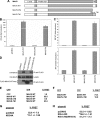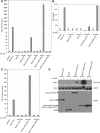MAVS self-association mediates antiviral innate immune signaling
- PMID: 19193783
- PMCID: PMC2663242
- DOI: 10.1128/JVI.02623-08
MAVS self-association mediates antiviral innate immune signaling
Abstract
The innate immune system recognizes nucleic acids during viral infection and stimulates cellular antiviral responses. Intracellular detection of RNA virus infection is mediated by the RNA helicases RIG-I (retinoic acid inducible gene I) and MDA-5, which recognize viral RNA and signal through the adaptor molecule MAVS (mitochondrial antiviral signaling) to stimulate the phosphorylation and activation of the transcription factors IRF3 (interferon regulatory factor 3) and IRF7. Once activated, IRF3 and IRF7 turn on the expression of type I interferons, such as beta interferon. Interestingly, unlike other signaling molecules identified in this pathway, MAVS contains a C-terminal transmembrane (TM) domain that is essential for both type I interferon induction and localization of MAVS to the mitochondrial outer membrane. However, the role the MAVS TM domain plays in signaling remains unclear. Here we report the identification of a function for the TM domain in mediating MAVS self-association. The activation of RIG-I/MDA-5 leads to the TM-dependent dimerization of the MAVS N-terminal caspase recruitment domain, thereby providing an interface for direct binding to and activation of the downstream effector TRAF3 (tumor necrosis factor receptor-associated factor 3). Our results reveal a role for MAVS self-association in antiviral innate immunity signaling and provide a molecular mechanism for downstream signal transduction.
Figures




Similar articles
-
TRAF5 is a downstream target of MAVS in antiviral innate immune signaling.PLoS One. 2010 Feb 11;5(2):e9172. doi: 10.1371/journal.pone.0009172. PLoS One. 2010. PMID: 20161788 Free PMC article.
-
DDX3 directly regulates TRAF3 ubiquitination and acts as a scaffold to co-ordinate assembly of signalling complexes downstream from MAVS.Biochem J. 2017 Feb 15;474(4):571-587. doi: 10.1042/BCJ20160956. Epub 2016 Dec 15. Biochem J. 2017. PMID: 27980081
-
MAVS-dependent IRF3/7 bypass of interferon β-induction restricts the response to measles infection in CD150Tg mouse bone marrow-derived dendritic cells.Mol Immunol. 2014 Feb;57(2):100-10. doi: 10.1016/j.molimm.2013.08.007. Epub 2013 Oct 4. Mol Immunol. 2014. PMID: 24096085
-
[MAVS protein and its interactions with hepatitis A, B and C viruses].Postepy Hig Med Dosw (Online). 2016 Jan 26;70:14-24. doi: 10.5604/17322693.1192925. Postepy Hig Med Dosw (Online). 2016. PMID: 26864061 Review. Polish.
-
Orchestrating the interferon antiviral response through the mitochondrial antiviral signaling (MAVS) adapter.Curr Opin Immunol. 2011 Oct;23(5):564-72. doi: 10.1016/j.coi.2011.08.001. Epub 2011 Aug 22. Curr Opin Immunol. 2011. PMID: 21865020 Review.
Cited by
-
Mitochondria and viruses.Mitochondrion. 2011 Jan;11(1):1-12. doi: 10.1016/j.mito.2010.08.006. Epub 2010 Sep 8. Mitochondrion. 2011. PMID: 20813204 Free PMC article. Review.
-
Modulation of Innate Immune Signalling by Lipid-Mediated MAVS Transmembrane Domain Oligomerization.PLoS One. 2015 Aug 28;10(8):e0136883. doi: 10.1371/journal.pone.0136883. eCollection 2015. PLoS One. 2015. PMID: 26317833 Free PMC article.
-
Mitochondrial factors in the regulation of innate immunity.Microbes Infect. 2009 Jul-Aug;11(8-9):729-36. doi: 10.1016/j.micinf.2009.04.022. Epub 2009 May 7. Microbes Infect. 2009. PMID: 19427399 Free PMC article. Review.
-
Influenza virus protein PB1-F2 inhibits the induction of type I interferon by binding to MAVS and decreasing mitochondrial membrane potential.J Virol. 2012 Aug;86(16):8359-66. doi: 10.1128/JVI.01122-12. Epub 2012 Jun 6. J Virol. 2012. PMID: 22674996 Free PMC article.
-
Virus-infection or 5'ppp-RNA activates antiviral signal through redistribution of IPS-1 mediated by MFN1.PLoS Pathog. 2010 Jul 22;6(7):e1001012. doi: 10.1371/journal.ppat.1001012. PLoS Pathog. 2010. PMID: 20661427 Free PMC article.
References
-
- Akira, S., S. Uematsu, and O. Takeuchi. 2006. Pathogen recognition and innate immunity. Cell 124783-801. - PubMed
-
- Chin, C. N., J. N. Sachs, and D. M. Engelman. 2005. Transmembrane homodimerization of receptor-like protein tyrosine phosphatases. FEBS Lett. 5793855-3858. - PubMed
-
- Choi, S., E. Lee, S. Kwon, H. Park, J. Y. Yi, S. Kim, I. O. Han, Y. Yun, and E. S. Oh. 2005. Transmembrane domain-induced oligomerization is crucial for the functions of syndecan-2 and syndecan-4. J. Biol. Chem. 28042573-42579. - PubMed
Publication types
MeSH terms
Substances
LinkOut - more resources
Full Text Sources
Other Literature Sources
Research Materials
Miscellaneous

